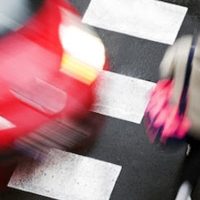Winning a Pedestrian Accident Case is More Difficult Than You Think

There is a misconception that when two cars collide, the case, or winning the case by proving liability, is difficult. Whereas, when a car hits a pedestrian, the case is easy—after all, cars aren’t supposed to hit pedestrians, and pedestrians are so very vulnerable to the impact of a multi-ton vehicle.
But in many ways, this actually ends up being the opposite—where pedestrians are hit by cars, the cases often turn out to be the more difficult to prove or win.
Because cars should never, even accidentally, strike a human’s body. It would seem like pedestrian accident cases are easier. So why aren’t they? It turns out, there are a number of reasons why car on pedestrian accidents are very difficult cases for pedestrians to win.
Rules of the road – Unfortunately many pedestrians don’t follow the rules of the road. Sometimes this is intentional—it may just be faster to cut across a street, or dart in front of traffic. Other times, it may just be accidental; many people are not nearly as educated as to the rules of the road when it comes to pedestrians, as they are the rules that govern how we operate cars.
Many pedestrians will cross a road where there is no crosswalk, or cross when the control signal has a red light or red hand, indicating pedestrians should wait to cross.
Whatever the reason, a Defendant who hits a Defendant will almost surely allege that the pedestrian did not follow the rules of the road. This can be very persuasive—and devastating to a pedestrian’s case, because should a jury find that the pedestrian was 51% or more responsible for the accident, the pedestrian/victim will recover no compensation at all.
Stereotyping – In many parts of the country, and here in Massachusetts, more of us might drive than walk. That means that we relate more, and sympathize more, with drivers. That means that jurors in your pedestrian accident case, think the same way. Unlike other kinds of accidents, where jurors may sympathize with someone who falls in a store, jurors may not sympathize as much with a pedestrian.
Evidence – When two cars collide, there is a lot of physical evidence. There is damage to cars, skid marks on the road, and the cars generally come to a stop around where the accident happened.
Police, and reconstruction experts, can use this information to piece together how the accident happened, in the event there is a dispute over who is at fault.
But this isn’t the case with pedestrian accidents. The fact a pedestrian may have hit her head, or suffered a broken rib, or broken his back, doesn’t really tell us much about how the accident happened. And because, sadly, pedestrians hit by cars tend to land far from where the impact actually happened, we cannot look at the location of the pedestrian after the accident, to see how it happened or who was at fault.
Injured as a pedestrian? Hire attorneys that know how to handle pedestrian accident cases. We can help. Call the Boston personal injury lawyers at The Law Office of Joseph Linnehan, Jr. today at 617-275-4200 for help.
Sources:
leg.state.fl.us/statutes/index.cfm?App_mode=Display_Statute&URL=0300-0399/0316/Sections/0316.130.html
bikewalkcentralflorida.org/resources/laws/
